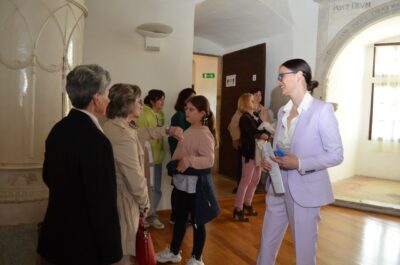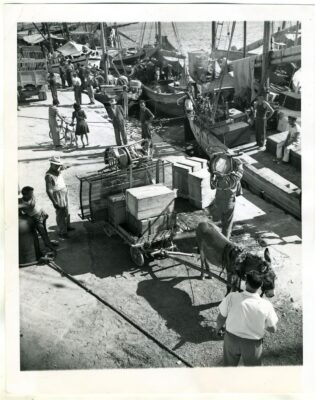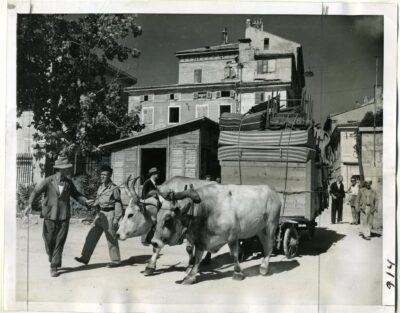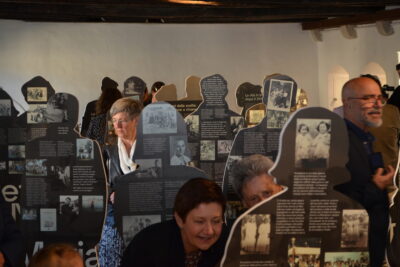By Dr.sc. Orietta Moscarda, Center for Historical Research Rovinj – Rovigno
Dr.sc. Tamara Nikolić Đerić
This project, conducted by the Ethnographic Museum of Istria, is about the displacement of part of the Istrian population after WWII and the consequences of that displacement which are still noticeable today. This so-called “Istrian exodus” is most clearly reflected in today’s relationship between people and their descendants who left Istria and the ones who stayed behind. The project also addresses and accentuates the social role that museums can play in facilitating communication and understanding among different groups and in raising awareness of the troubled past shaping the reality of today’s Europe.

Why was this topic chosen and why is it important to talk about it today?
The Ethnographic Museum of Istria was founded in 1962 as the successor of the short-term People’s Museum which had the mission to promote the Slavic origins of Istria. Following the vision of the newly established leadership of the region in the 1990s, supporting its multi-ethnic and culturally diverse community, the museum engaged in critically analysing the many faceted interpretations of the local culture, starting with the 17th century adventurous and often romanticised writings of priests and professional travellers, followed by the Austrian Empire’s political project, accentuating the multi-ethnicity of its vast geographical space in order to control and rule it, and finally the selective strategies of Yugoslavia for building a stronger collective identity and proving its Slavic origins. Equipped with a new mission and staff, the museum directed its endeavours towards researching and communicating the diverse elements of the local culture, including both its Italian and Slavic components. In developing its researchers and curators, in the last thirty years the museum staff has collaborated with many ethnic communities, including Montenegrin, Albanian and Roma. Of course, the museum has also always been aware of a significant number of Istrians living outside Istria.
This research orientation led to the 2009 exhibition “Suitcases and Destinies: Istrians Outside of Istria”. Working with different types of migrants leaving Istria since the early 1920s for different reasons, enabled researchers to identify a specific migration process, known as the “Istrian Exodus”. This migration process was included in the overall exhibition, but very soon it became clear that it deserved specific attention. This was due to the ongoing communication among the community that left (esuli), the those who stayed (rimasti), their descendants, and the political powers from both the Italian and Croatian sides who still today often use the tragic events of the aftermath of WWII for political benefit.
As an institution supporting intercultural dialogue, the Ethnographic Museum of Istria realised that the topic of the Istrian exodus is of utmost importance not only to shed light on these events among the citizens who were/are not aware of Istria’s tragic past, but also because people from both sides needed a space for dialogue and self-representation which now after 70 years seemed to be achievable. The project ‘Esuli e Rimasti: Building Dialogue in a Divided Community’ seeks to confront the official historical ‘truths’ with personal narratives coming from different sides in order to sensitise the public on the personal nature of history[1]The authors understand historical subjectivity as not opposed but in relation to historical objectivity as explained in Susan A. Crane. ‘Historical Subjectivity: A Review Essay’. The Journal of … Continue reading and allow us all to empathise with everyone who had to leave or are leaving where their roots are.
“My advice to everyone would be to stay where they were born, it’s the most beautiful thing. Look at Sergio Endrigo’s song ‘where the tree was born’… it’s something that hurts me and my wife doesn’t want me to put this record on because I always cry… Here, it made me shed two tears now.” (Informant Egidio, August, 2020)
Historical background
World War II found Istria under Italian rule as a result of World War I and the break-up of Austria-Hungary, its former ruler. From 1920 until 1943, Italian rule in Istria escalated under the fascist regime. It was characterised by bans, persecution, humiliation and transformations negative for the identity and sustainability of Croatians (and Slovenians) in Istria. Many of them, together with anti-fascist Istrians, emigrated, most often to the former Yugoslavia. It was, in fact, the first major wave of emigration due to totalitarian regimes in the 20th century. The project of the Ethnographic Museum of Istria also focuses on yet another mass exodus, greater in numbers, also referred to as “the big exodus”, that happened in the aftermath of WWII.

The mass departure of Italians, accompanied by substantial numbers of Croatians and Slovenians, from Istria and Rijeka after the Second World War is understood as a particular type of forced or coerced displacement of an indigenous national community from their homeland. The ways in which it was implemented are different from expulsions, but they achieved the same results. The migration did not take place on the basis of bilateral agreements for the exchange of populations, nor following official expulsion actions. However, it was largely implemented through Article 19 of the Peace Treaty of 1947, which greatly favoured Italian citizenship. This right was granted in cases where substantial national minorities were created following a border shift established by a treaty. In the case of the Italians of Istria and Rijeka, the option was an instrument of mass migration, which led to changes and transformations on the Istrian peninsula at the national or ethnic and socio-cultural levels.
The right of option for Italian citizens, which constituted the legal aspect of most of the migratory flow, was provided by the 1947 Peace Treaty (‘first options’ of 1948), by the agreements for reopening in 1951 (‘second options’) and the London Memorandum (1954). Over a decade, approximately 200,000-250,000 people residing in the former provinces of Pula and Rijeka opted for Italian citizenship and moved to Italy. The difficulty in quantifying the exodus is linked to the fact that national membership in Istria was very uncertain, which is why it is impossible to establish the original national composition of all the people who left the territory. In addition, those who made use of the right of option, provided by the 1947 Peace Treaty, indicated Italian as their language of use.
The reasons for the exodus are linked to a whole series of political, ideological, economic, social and cultural aspects. After World War II, Istria and Rijeka experienced the introduction of a communist regime. In addition, since 1945-1946, the political struggle for the annexation of the territories claimed by Yugoslavia (i.e. the whole territory of Venezia Giulia up to the Isonzo/Soča), accompanied by the other strategic objective of socialist revolution, led the Istrian population to divide into two large blocs, in favour of the Yugoslav option or not.
Although the Yugoslav regime’s official policy towards the Italians was marked by “Italo-Slavic brotherhood”, a vast number of the Italian population, which as a whole perceived itself as the object of persecutory policies aimed at destroying their national identity, chose the Italian citizenship option. Nevertheless, Croatian and Slovenian citizens were also leaving Istria. For the Italian component (understood in all its social articulations), the exodus represented the rejection of the new national hegemony, but also a response to the radical change in economic, social and cultural conditions due to the politics of the new Yugoslav communist regime. On the other hand, for many Croatian and Slovenian citizens, the option represented a possibility to escape the harshness of the communist regime, especially in the economic sector.
The choice to leave the territory, which came on the basis of the right of option, was not a decision free from political constraints, pressures and even violence. The whole period of the first and second options (1948-1951), which coincided with the anti-conformist repression (from 1948), up to the demonstrations against Italy of 1953-1954, were marked by different levels of intimidation, violation of rights and real repression by state structures (secret police and party committees), marked by Stalinist methods such as withdrawal of documents, ration cards, dismissals, evictions, forced recruitment to the Lupogliano-Stallie railway, beatings, imprisonment, torture and disappearances.

The Yugoslav authorities attempted to curb the requests, rejecting thousands, forcing the applicants to stay and live within the framework of the state of Yugoslavia. Many rejections in the later phase were linked to the high numbers of “options” among the Croatian and Slovenian population, the failure of the “unity and brotherhood” policy towards the Italian population, the loss of a real consensus of the population in general, and the need to keep some specific professions within the country. The phenomenon of clandestine escapes is closely related to rejected options. These occurred by sea, particularly from the Kvarner islands, but frequently also by land. People tried to leave Yugoslavia for political reasons (anti-communism, rejection of the option), to avoid military service (three years in the navy), for economic reasons (hunger and poverty) and adventure, and because of the harshness of the communist authorities. These escapes increased further in 1949 when, at the conclusion of the first options (March 1948), numerous citizens who had not benefited from this right or whose application had been rejected, attempted to flee to Italy, or at least the West, by any means. During illegal expatriation, especially along the demarcation lines between the former Yugoslavian Istrian territory and zone B, some young people even died at the hands of the People’s Guards or the secret police. The Italian minority remaining in Istria and Rijeka was and is still institutionally represented by the Union of Italians of Istria and Rijeka.
The work process: methods used and cooperation developed
The research process was designed from a multidisciplinary perspective, including not only ethnographic methods of semi-structured interviews and participant observation, but was also enriched through close cooperation with the Rovinj History Research Centre and joint creation and interpretation strategies with the subjects of the research as a relatively new approach in social history studies. The collaboration with the centre in Rovinj was extremely important, as this institution was established in 1968 by the Italian Union, the most important non-political entity championing the rights of the Italian minority in Croatia and Slovenia. “The Centre was conceived as a relevant scholarly and research institution, the task of which is to engage in objective processing of facts, customs and events in the area of the complex history of Istria, specifically because of its geo-political situation and the principles of multi-ethnicity and multiculturalism adopted long ago, with an emphasis on the Italian minority.”[2]crsrv.org Thus, their role over the last 53 years has actually been to support the Italian community that stayed in Istria, and to research the consequences of the migration, and establish to dialogue with the ones that left.
Although the Istrian Exodus has been researched by many historians and social scientists in the last few decades, and there are many associations and informal groups transmitting the memory of these events, these are mostly done by the Italian side, thus leaving a vast number of Croatian citizens in Istria without any knowledge on what happened to a large number of its citizens after WWII. The local Croatian Identity on the Line project has the role of facilitating access to information on the historical events connected with the mass migration from Istria after WWII to a wider audience, and to open a dialogue between migrants and their descendants with the people who stayed and the ones who are not directly connected to the events but are living their consequences.

Besides the historic background provided by the Rovinj Centre as a result of their long-lasting research, the Identity on the Line project foresaw semi-structured interviews with Italians who left and the ones who stayed. We wanted to hear both sides, because, with the years passing, some misunderstandings arose not only between Croatians and Italians from Istria but also among Italians themselves.
‘They don’t like us, because we are the proof that they didn’t have to leave.’ (Informant, Rovinj, September 2020)
The intention of the project was to collect enough interviews from both sides to show how each personal story is affected by general, national or international political decisions, but at the same time has its own micro-strategies to cope with difficult life events. We planned to conduct the interviews during the first 8 months of 2020 visiting parts of the community in Italy, Belgium and the United States of America, and waiting to meet some who are still visiting Istria during the summer months.
Due to the Covid-19 pandemic, which impeded direct contact, it was challenging to conduct 30 sensitive interviews with people we did not know. The tensions and the fear of infection were too high and even if the digital literacy of the older informants was on an advanced level it proved impossible to conduct interviews on highly sensitive topics with ‘strangers’ using digital platforms. The informants needed a safe space to talk to people whom they know or at least had some previous contact with. The researchers of the Ethnographic Museum of Istria conducted 10 interviews live in Istria between July and September 2020. For the rest, a specific method was developed, which consisted of training two younger researchers, both part of the community of migrants and Italians in Istria, to conduct the interviews. This proved successful, because what we needed in times when direct contact with informants was lacking, were ‘facilitators’ who have good relationships with, and are trusted by the informants and their wider community. Significant help was provided by the Association of Italians in Vodnjan/Dignano (Comunita’ degli Italiani di Dignano).
Stories collected
The stories collected reflect two sides of the events happening in Istria during WWII and its aftermath. This region, with considerable national and cultural diversity, faced marked divisions among its population. The choices that were made were influenced not only by national affiliation but also by ideological and economic factors. Some stayed and others left. Both communities faced specific difficulties as a consequence of their ‘choice’.
Well … I was a child, 10-11 years … when I came away … and the decision was that in short, according to our family, according to many people who were leaving, … We went away because it was not possible to live with people of different mentality and their actions…we did not even have the freedom, let’s speak openly, we did not even have the freedom to speak, to tell the truth because we felt bad, we were afraid. The fact is that the Italian dignanesi who left were all afraid of ending up in sinkholes, as Marshal Tito had given the order for ethnic cleansing, that is, many people ended up in sinkholes whose only fault was that they were Italian. He prohibited many things, then those who were not obedient would end up in prison or ended tragically in the sinkholes. (Informant Luigi Donora, Vodnjan, August 2020)
***
So I was born in 1936, in 1945 I was 9 years when the liberation came … and I remember how on the square near the church everyone …the youth, little girls, played and joked, everything. And all of a sudden after two, at the most three years, I was left alone. The doors of the houses were all closed, I was wondering where they were, where all these people had gone. I remained all alone, I lived right down near the church, I was born there, and my mom and dad stayed at home alone with my grandmother. Their relatives had all gone away, from my father and from his mother’s side, uncles, cousins, disappeared …As a child I didn’t know what was happening…my mom and dad didn’t care about anything, they were farmers, simple farmers. My dad said, well they won’t throw me out of the house, I’m staying in Vodnjan. Because he was a peasant, he didn’t have a profession and said: ‘Where can we go?’ … (Informant Lina, Vodnjan, August 2020)
***
My mom told me that one night she went dancing, there a ‘titino’ asked her to dance, but she didn’t want to because she was there with friends. In the end, the Tito soldier took her to the police station, made her stay there in her cell all night, who knows what would have happened if she hadn’t been released by her brother with a trick.
In 1949 they left for Italy and were sent to the Refugee Camp of Servigliano in the Marche region. They all left … my grandmother, my mom, my aunt and her two children, and my two uncles who went abroad: one is now in Sweden, the other in Canada where as soon as they arrived they quarantined, they had to take language courses to live there.
At the beginning in Servigliano it was tough, but over time my mother also got on very well with the locals with whom she had no difficulty in socialising. My grandmother, on the other hand, was then very ill and died in the refugee camp. In fact, she is buried in the cemetery of Ancona. (Informant, Marina Budicin, Torino, April 2021).
Reflections on challenges and most important outcomes
During the period of two years (February 2020-February 2022), marked by the Covid-19 pandemic, which changed everyone’s working conditions, the Ethnographic Museum of Istria managed to conduct 30 sensitive interviews with esuli (migrants) and rimasti (people who stayed, usually of Italian origin), developed an exhibition, participated in the making of a documentary film, organised a seminar and facilitated guided tours covering diverse topics that emerged from the research. This was possible thanks to collaboration with the Rovinj History Research Centre and two facilitators who were part of the community, namely Giulia Cnapich and Marina Paoletić. The biggest challenge was to reach people during the pandemic and afterwards to adapt to the ‘new normal’. This means that the numbers of people attending the events had to be lower and digital platforms continued to play a vital role in evaluating our work. Even so, we believe that this situation led to new methodologies and interpretation strategies, confirming that participation and collaboration are crucial in researching sensitive topics. We reached and included our public earlier in the process, this being our biggest and most valuable achievement in disseminating stories and raising awareness meaningfully.

What surprised us somewhat was the very complex relationship between the emigrants and those who stayed. There are different dynamics and qualities of these relationships, which have not been researched so far, because the studies have focused mostly on emigrants. However, those members of the Italian community who did not emigrate found themselves in a gap between suspicions on both sides: the local authorities in the former Yugoslavia, and the emigrants. The latter wondered why they stayed behind, and at the same time they were living proof that one could somehow survive by staying. Today, it seems to us that some members of the remaining Italian community want to close this topic forever and are fed up with the story of the exodus. Yet unresolved issues and untold stories remain a covert source of misunderstanding and frustration.
When (re)thinking the role of a museum related to this kind of difficult heritage, we again realised that by sharing private, intimate yet traumatic experiences with museum professionals and by putting them in a wider context of similar testimonies and historical framework, many informants felt and understood that this is not only their (or their community’s) experience and destiny, but a tough phase of life common to many Europeans. And that can be – to a certain degree – a comforting realisation.
References and footnotes
